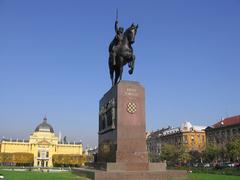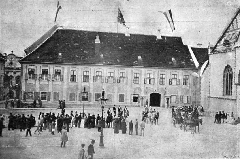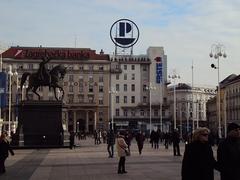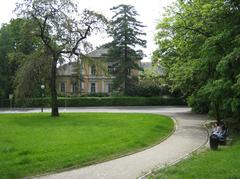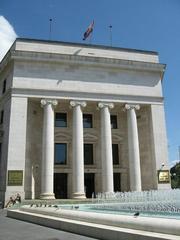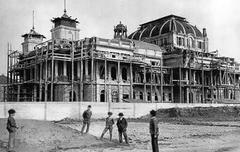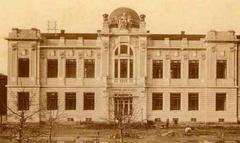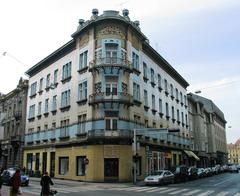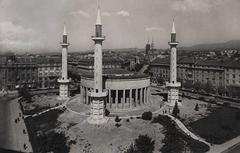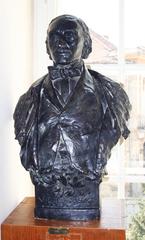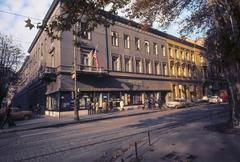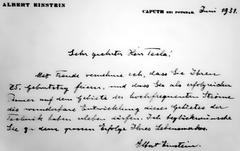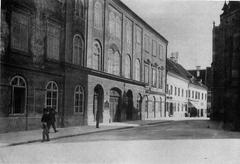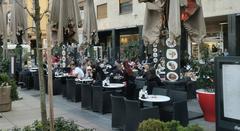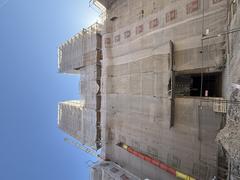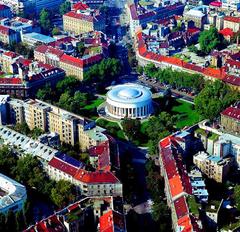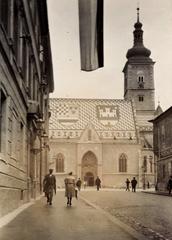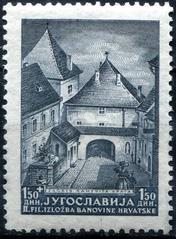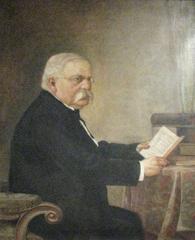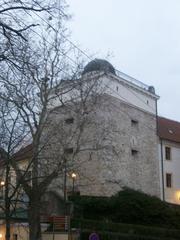Croatian Music Institute Zagreb: Visiting Hours, Tickets & Complete Guide
Date: 04/07/2025
Introduction
Located in the heart of Zagreb, the Croatian Music Institute (Hrvatski glazbeni zavod, HGZ) is Croatia’s oldest continuously active music institution and a foundational pillar of the nation’s musical heritage. Established in 1827 during the Croatian National Revival, it has shaped the city’s and country’s musical and cultural landscape for nearly two centuries. The Institute’s dedication to music education, performance, and preservation has made it a premier destination for music lovers and cultural travelers alike (Croatia Week; Wikipedia).
Its historic building on Gundulićeva Street, inaugurated in 1876, was Zagreb’s first purpose-built concert hall and remains a vibrant venue for concerts, workshops, lectures, and exhibitions. The Institute’s archives, containing rare manuscripts and scores, further enrich the visitor experience. Whether attending a concert or exploring Zagreb’s history, the Croatian Music Institute offers a unique cultural journey (Croatia Week; Musau.org).
This guide provides all essential information on the Institute’s history, visiting hours, ticketing, accessibility, and visitor tips, ensuring you enjoy a fulfilling experience at one of Zagreb’s premier cultural sites (Divan; Time Out Croatia).
Table of Contents
- Historical Overview
- Visitor Information
- Frequently Asked Questions (FAQ)
- Plan Your Visit & Stay Connected
- Summary & Final Tips
- References
Historical Overview
Founding and Early Development (1827–1876)
The Croatian Music Institute was founded in 1827 as “Societas Philharmonica Zagrabiensis,” a significant step in Zagreb’s cultural development when the city had just 10,000 inhabitants. Inspired by prominent European music societies, the Institute’s mission was to foster musical appreciation and education. Its first concert, performed by an amateur orchestra of Institute members, marked the beginning of a rich tradition (Croatia Week; Wikipedia).
By 1829, it established a music school that laid the groundwork for today’s Zagreb Academy of Music. The Institute also began building its library and archival collections, preserving rare manuscripts and scores that remain invaluable to researchers today (Musau.org).
Becoming a National Cultural Center (1876–1918)
The opening of the Institute’s building on Gundulićeva Street in 1876, the first purpose-built concert hall in Zagreb, solidified its central role in Croatian culture (Croatia Week). The Institute fostered local talent and promoted both Croatian and European music. Its music school, eventually recognized as a conservatory in 1916, became a leading center for music education (Musau.org).
The Institute’s statutes and archives from this era, shaped by figures like Vatroslav Lisinski, reinforce its mission as a national society dedicated to the advancement of musical art and science (Wikipedia).
Innovation and Internationalism (1918–1945)
Between the World Wars, under Arthur Schneider’s leadership, the Institute became an influential center for contemporary music. It introduced innovative concert series and brought works by Arnold Schoenberg, Béla Bartók, and other modern composers to Zagreb audiences. The Institute was lauded internationally for its dedication to new music, even amid financial constraints (Musau.org).
During this period, the concert programming reflected a cosmopolitan approach, featuring works by 143 living composers from across Europe.
Postwar Resilience and Modernization (1945–Present)
After World War II, the Institute remained an independent association, primarily funded through its activities rather than state support. The concert hall has hosted renowned artists such as Franz Liszt, Sviatoslav Richter, and Mstislav Rostropovich (Wikipedia). The building, damaged in the 1880 and 2020 earthquakes, has undergone several restorations and is a protected cultural monument (Croatia Week).
Recent years have seen expanded programming, renovations, and the addition of literary and film events, sustaining the Institute’s relevance and appeal (Croatia Week).
Legacy and Significance
The Institute’s legacy includes founding Zagreb’s first music school and the Music Academy, nurturing generations of musicians and conductors. Its archives and library are a trove for music historians, while its concert hall continues to showcase world-class performances. As it nears its 200th anniversary, the Institute remains a symbol of Croatian musical tradition and innovation (Musau.org).
Visitor Information
Location & How to Get There
- Address: Gundulićeva 6–6a, Zagreb, Croatia
- Transport: Easily accessible by tram (lines 12 and 13, stop at Kvaternikov trg) and by foot from central Zagreb sites. Limited parking is available nearby, but public transport is recommended (Divan; Visit Zagreb).
- View on Map
Opening Hours
- The Institute is open to the public Monday to Friday from 11:00 to 14:00, and one hour before scheduled concerts or events (Divan).
- The box office typically operates weekdays from 10:00 to 18:00 and during events.
- Always check the official website for up-to-date schedules.
Tickets & Pricing
- Tickets for concerts and events can be purchased online or at the box office.
- Typical prices: 50–150 HRK (approx. 7–20 EUR), with discounts for students, seniors, and groups.
- Entry to lobby exhibitions is free, usually available half an hour before events and during intermissions (Divan).
- Late arrivals may enter the hall only during a break or applause.
Guided Tours
- Guided tours of the historic building and archives are available by advance appointment.
- Tours highlight the grand staircase, concert hall, and library, and can be arranged in English or other languages.
- Contact the Institute in advance to schedule a tour (Divan).
Accessibility
- The building does not have an elevator or accessible toilets, but visits for wheelchair users or those with mobility difficulties are possible with prior arrangement.
- Contact the secretariat at least one day before your visit to ensure staff assistance.
- Assistance is also available for visually impaired visitors (Divan).
Special Events & Programs
- The Institute hosts regular classical concerts, chamber music, competitions, literary evenings, workshops, and exhibitions.
- Notable events include the Vaclav Huml Prize (violin) and Svetislav Stančić Prize (piano) competitions (Time Out Croatia).
- Events often coincide with citywide festivals, like “Saturdays in Zagreb” (Find Croatia).
Visitor Etiquette & Photography
- Dress respectfully; sneakers, tracksuits, and hiking attire are discouraged.
- Silence mobile devices and avoid disruptive behavior during performances.
- Photography is generally not permitted during concerts, but may be allowed in the lobby or during exhibitions—ask staff for guidance.
Nearby Attractions
- The Institute’s central location allows easy access to:
- Croatian National Theatre
- Zagreb Cathedral
- Ban Jelačić Square
- Museum of Contemporary Art
- Tkalčićeva Street’s cafés and nightlife (Visit Zagreb)
Frequently Asked Questions (FAQ)
Q: What are the Croatian Music Institute’s visiting hours?
A: Monday–Friday, 11:00–14:00, and one hour before scheduled events.
Q: How can I buy tickets for concerts?
A: Purchase online via the official website or at the venue.
Q: Is the Institute accessible for visitors with disabilities?
A: Visits are possible with prior arrangement, as there is no elevator or accessible toilets. Contact the secretariat ahead of time.
Q: Are guided tours available?
A: Yes, by advance appointment, in multiple languages.
Q: Are there free exhibitions?
A: Yes, exhibitions in the lobby are free and open before events and during intermissions.
Q: Can I take photographs inside?
A: Photography is generally restricted during performances but may be allowed in public areas; consult staff for details.
Plan Your Visit & Stay Connected
To make the most of your visit:
- Check the official schedule and ticketing in advance.
- Arrive early to enjoy exhibitions and the building’s historic ambiance.
- Explore nearby attractions in Zagreb’s city center.
- Follow the Institute on social media for updates on events and programs.
- Download the Audiala app for curated cultural event listings and notifications.
Summary & Final Tips
The Croatian Music Institute is a vital cultural institution and living monument to Croatia’s musical tradition. Its historic building, world-class acoustics, and diverse programming offer visitors a profound connection to Zagreb’s artistic heritage. Whether you attend a concert, join a guided tour, or simply admire the architecture, the Institute is an essential stop for anyone exploring Croatian culture.
Plan your visit in advance, especially if you require special assistance or wish to join a tour. Take time to explore nearby landmarks and enrich your cultural experience in Zagreb.
References
- The Amazing Restoration of the 130-Year-Old Grand Staircase at Croatian Music Institute, 2021, Croatia Week (Croatia Week)
- Croatian Music Institute, 2024, Wikipedia (Wikipedia)
- Founding and Development of the Croatian Music Institute, 2023, Musau.org (Musau.org)
- Photos: A Look Through the Impressive Croatian Music Institute, 2023, Croatia Week (Croatia Week)
- About Croatian Music Institute, 2023, ccsv.ca (ccsv.ca)
- Visiting the Croatian Music Institute: Guide, 2024, Divan (Divan)
- Croatian Music Institute, 2024, Time Out Croatia (Time Out Croatia)
- Croatian Music Institute and Zagreb Cultural Sites, 2024, Find Croatia (Find Croatia)
- Visit Zagreb – Official Site, 2024 (Visit Zagreb)

